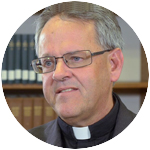
Father Thomas Dailey, O.S.F.S.
Centuries ago, St. Francis de Sales (1567-1622) envisioned the future of the world as one in which all hearts, both human and divine, would be connected in a harmonious state of life and love.
But it’s pretty clear from human history that we have not arrived there; in fact, our contemporary experience demonstrates that we have a long way to go.
This week’s solemnity of the Sacred Heart of Jesus celebrates how to get there.
Our journey to eternal life has begun and has been set on the right course thanks to God’s “visitation” of this world in the person of his Son, Jesus. In his life, death, resurrection and ascension, we discover all that we need for our eternal salvation.
Particularly on the cross, where his Sacred Heart is pierced open to pour out the full graces of redemption (John 19:33-37), we see what God’s love means, what it has done for us and what it enables us to do in response.
[hotblock]
In his “Treatise on the Love of God,” Francis de Sales offers his own response to encountering that Sacred Heart. With poetic reverie, he writes: “O love eternal, my soul needs and chooses you eternally!” And he prays, “Come Holy Spirit, and inflame our hearts with your love … so that we may not die eternally” but “may live in your eternal love, O Savior of our souls.”
Later, that mystical wisdom comes to full expression in the revelations of Jesus to St. Margaret Mary Alacoque (1647-1690), a nun in the Order of the Visitation of Holy Mary, which was founded by St. Francis de Sales and St. Jane de Chantal. From her visionary experiences of the Sacred Heart, today’s form of the devotion has arisen.
We, too, can comprehend the love of Christ for us and for all humanity by gazing prayerfully upon that sacred image and icon. Jesus himself tells us as much — in the only autobiographical description of his heart:
“Come to me, all who labor and are heavy laden, and I will give you rest. Take my yoke upon you, and learn from me, for I am gentle and lowly in heart, and you will find rest for your souls. For my yoke is easy, and my burden is light” (Matt. 11:28–30).
That alluring invitation draws us to tap into a new reality and respond to the divine plea by learning what Jesus wishes to reveal to his own “little children.”
To all those who desire happiness, he says, “Come to me” — not to the self-proclaimed and self-serving followers of secular culture, whose perspectives are limited to this world.
To all who seek meaning in life, he insists, “Learn from me” — rather than trusting in partial human knowledge and being guided by passions and inclinations, fickle as these will be.
[hotblock]
He can claim, “I am gentle,” for his deeds show love and mercy shared with all the world, despite our indifference toward him and our sins against him.
And he rightly identifies himself as “lowly in heart,” for he has need of nothing for himself, but wants only for us to know how much we are loved and for us to return love for love by how we treat one another.
That’s the love that alone gives rest for our souls, the love manifest to us in the Heart of Jesus. To quote St. Margaret Mary, the Sacred Heart reveals “all its treasures of love, mercy, grace, sanctification, and salvation … in order that those who were willing to do all in their power to render and procure for him honor, love, and glory might be enriched abundantly, even profusely, with these divine treasures of the Heart of God, which is their source.”
Meditating upon the Gospel images of Jesus’s heart, we can appreciate and appropriate the love of Christ for us. For each time we gaze prayerfully upon that icon of divine love, something else happens. Not only do we look upon it, but also it looks back at us.
Contemplating the Sacred Heart of Jesus draws us into a personal encounter with him and invites us to dare to come close to love itself. There we can experience saving grace when we surrender our sins, our wounds, even our desires to him who has opened his heart for us with such indescribable mercy.
Seeing the heart of Christ, and being seen by it, helps us realize that our best hope in this world lies not in the fleeting emotions of our human hearts, but in the steadfast power of divine love.
***
Father Thomas Dailey, O.S.F.S., is the John Cardinal Foley Chair of Homiletics and Social Communications at St. Charles Borromeo Seminary, Wynnewood. This commentary is adapted from the conclusion to his book, “Behold This Heart: St. Francis de Sales and Devotion to the Sacred Heart” (Sophia Institute Press, 2021).



Share this story